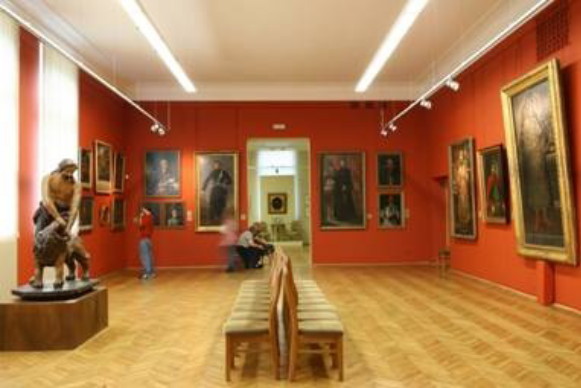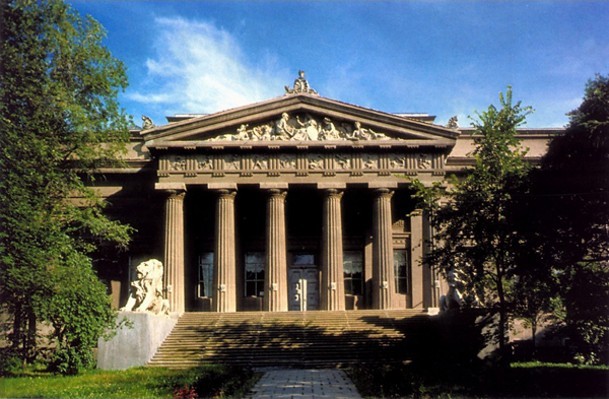National Art Museum of Ukraine
National Art Museum of Ukraine (Національний художній музей України; Natsional'nyi khudozhnii muzei Ukrainy). The central art museum of Ukraine. It was founded in 1936 when the holdings of the All-Ukrainian Historical Museum were divided into a historical and an artistic collection. The former became the basis of the Kyiv Historical Museum (now National Museum of the History of Ukraine), the latter of the Kyiv State Museum of Ukrainian Art, which was renamed Kyiv Museum of Ukrainian Art in 1953. From 1954 to 1964 a collection of Ukrainian folk art, which became the Kyiv Museum of Ukrainian Decorative Folk Art, constituted a branch of the Kyiv Museum of Ukrainian Art. In 1994 it was granted a national museum status and assumed its present name. The museum is divided into three sections: old Ukrainian art, 19th- and early-20th-century Ukrainian art, and the Ukrainian art of the 20th century. The first encompasses artistic works from the 12th to the 18th centuries: rare icons such as Volhynian Mother of God (14th century), St George the Dragon-Slayer (early 15th century), and The Holy Protectress (13th century); 17th- and 18th-century portraits, including the portraits of Mykhailo A. Myklashevsky, the colonel of Starodub (18th century), of D. Yefremov, the otaman of the Don Cossack Host (1752), of V. Hamaliia (mid-18th century), of P. Sulyma (mid-18th century), and The Crucifixion with a Portrait of L. Svichka (late 17th century); folk paintings of Kozak-Mamai; and fine prints and samples of the earliest Ukrainian sculptures. The second section, devoted to the 19th and early 20th centuries, contains some valuable works of the portraitists Dmytro H. Levytsky and Volodymyr Borovykovsky (most of their works are preserved at the Kyiv Picture Gallery National Museum); the works of Taras Shevchenko and his followers Ivan Sokolov, Lev Zhemchuzhnikov, and Kostiantyn Trutovsky; the paintings of Porfyrii Martynovych, Mykola Kuznetsov, Mykola Pymonenko, Kyriak Kostandi, Serhii Svitoslavsky, Petro Nilus, and Petro Levchenko; the paintings and portraits of Oleksander Murashko; the landscapes of Serhii Vasylkivsky; and the works of Ivan Trush, Fotii Krasytsky, Hryhorii Svitlytsky, Mykola Samokysh, and Fedir Krychevsky. The largest section is the one devoted to Soviet art. It contains posters of the revolutionary period; the works done in the 1920s and 1930s by prerevolutionary masters such as Ivan Izhakevych, Mykola Samokysh, Vasyl H. Krychevsky, Fedir Krychevsky, Oleksander Bohomazov, Mykhailo Boichuk, Tymofii Boichuk, Vadym Meller, Davyd Burliuk, Alexandra Ekster, Viktor Palmov, Hryhorii Svitlytsky, Vasyl Kasiian, Anatol Petrytsky, Oleksii Shovkunenko, Karpo Trokhymenko, Mykola Burachek, Abram Manevich, and Ivan Kavaleridze; works done after the war by Mykhailo Bozhii, Viktor Zaretsky, Tetiana Yablonska, Yevhen Volobuiev, Opanas Zalyvakha, Ivan Marchuk, Valentyn Zadorozhny, and Feodosii Humeniuk; Transcarpathian and Galician art by Yosyp Bokshai, Adalbert Erdeli, Antin Kashshai, Andrii Kotska, Fedir Manailo, and Olena Kulchytska; and contemporary works by such artists as Arsen Savadov and Oleh Holosii. The museum holds about 40,000 items. The museum building, which was erected in the Neoclassical style in 1897–1900 by Vladyslav Horodetsky and G. Boitsov and decorated by Elia Sal, was enlarged in 1972 so that the exhibition area doubled.
Sofiia Yaniv
[This article was updated in 2010.]
.jpg)
.jpg)

.jpg)
